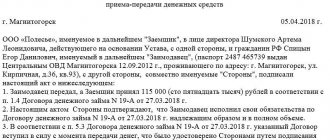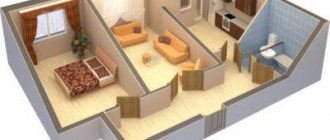What it is
According to Chapter 611 of the Civil Code of the Russian Federation, the lessor, that is, the person who is the owner, is obliged, in accordance with the agreement, to provide the tenant with property in satisfactory condition for temporary use.
However, this is a very ambiguous concept.
According to the same article of the Civil Code, satisfactory condition is considered to be the condition of a real estate object that allows it to be used for its intended purpose.
The lease agreement is preliminary and without an act of acceptance of the transfer of the premises for rent has no legal force. It is issued to confirm the fact of transfer of the object for rent.
After signing it, the tenant will not be able to unilaterally terminate the agreement prematurely due to the impossibility of using the leased property for its intended purpose. The act is drawn up as an annex to the lease agreement and records the condition of the office or other premises at the time of transfer to the tenant.
The document reflects:
- Availability or absence of water supply and heating.
- Problems with electricity, wiring.
- Total area of the object.
- Condition of walls, floors, ceilings, window openings.
Certificate of acceptance and transfer of non-residential premises (filling sample)
Moscow April 1, 2020
We, the undersigned, the Lessor - NPAO "Convent-Plus", represented by General Director Ivan Ivanovich Ivanov, acting on the basis of the Charter, and the Tenant - NPAO "Solnyshko", represented by General Director Petrov Petr Petrovich, acting on the basis of the Charter, have drawn up this act about the following:
The Lessor rented out and the Tenant accepted for rent non-residential premises with a total area of 20.3 sq. m. m, located at the address: 121087, Moscow, Bagrationovsky Prospect, building 7, bldg. 20 "B".
The premises being leased, according to the Cadastral passport dated November 23, 2010, inventory number 815/6 (03200189), consists of room No. 6, as well as part of room No. 5, located in the premises on the 7th floor of the building.
Purpose of the premises: office.
Taking into account its normal wear and tear, the premises are in satisfactory technical condition and suitable for use in accordance with its purpose.
The Tenant has no complaints regarding the condition of the premises.
This Act is drawn up in two copies, one for each of the Parties, and is an integral part of the Lease Agreement for non-residential premises No. 18 dated April 1, 2020.
Necessity
According to the law, a document is never drawn up separately, has no value and has no weight. It is an integral part of the rental agreement.
In its absence, the agreement between the landlord and the tenant can be declared invalid in court. The main purpose of the act is to record the condition of the leased object at the time of transfer by the owner to the tenant, as well as confirmation of the fact of transfer itself.
In addition, there are a number of other reasons that require its registration:
- Contains financial aspects, term, amount, and method of payment.
- Records the state of the object at the time the object is provided for rent.
- Contains a list of the tenant's obligations in relation to the leased property.
According to the law, a lease agreement can be concluded for any period. The minimum contract period is one day. All agreements concluded for a period of more than one year are subject to mandatory registration with Rosreestr.
Upon expiration of the validity period, a new real estate lease agreement and an acceptance certificate for the delivery of premises are concluded.
Sample 2020
There are rules for document execution. It is conventionally divided into two parts: the head and the main part. The header must include the following information:
- name of the document, date of registration, its serial number;
- description of the parties to the agreement. If these are individuals, you must indicate their passport details. If these are legal entities, their name, passport details of managers, and their position are indicated;
- the name of the contract object, its address, and area;
- cadastral number, number of the certificate of registration of ownership.
The main component of the act contains the following information:
- state of the object. This column describes the condition of the floor, window openings, walls, ceiling;
- the presence or absence of communications, the condition of the wiring, existing problems are reflected;
- if the property is leased with access to the Internet, telephone connection, equipment, furniture, this must be stated in the document.
Responsibility for compilation
The tenant is legally responsible for completing the document. The document is always drawn up in two identical copies for each party.
One copy is given to the owner of the property, the second remains with the compiler, that is, with the tenant. If the tenant leases an object for more than a year, he must register the document drawn up with Rosreestr. Both parties should review the document before signing it.
If anyone has claims or disagrees with the terms of the act, an additional protocol is drawn up.
IMPORTANT! All acts of acceptance and transfer of non-residential real estate are stored throughout the entire period of their validity, as well as for 36 months from the date of expiration of its validity.
Why do you need a transfer and acceptance certificate for non-residential (residential) premises?
By law, the tenant is responsible for the condition of the rented premises. Therefore, in the sample act of acceptance and transfer of a real estate property, it is necessary to describe this object, as well as list the landlord’s things that remain on the premises. The presence of the document will help in resolving disputes regarding the condition of the real estate accepted for use.
When concluding a lease agreement, the lessor is more interested in drawing up the act, since the document establishes the actual condition of the property being transferred for temporary use, which the tenant is obliged to return in the same proper form.
When terminating a lease agreement, the tenant is interested in having an acceptance certificate for residential or non-residential premises. The document will allow you to prove that the identified defects in the property were present at the time of transfer of the property, and the tenant does not have to pay for them.
Certificate of acceptance and transfer of premises for rent
The transfer and acceptance certificate is drawn up in order to confirm the very fact of transfer of the object, but also to record the state of the object at the time of transfer. Thus, the landlord will subsequently be able to hold the unscrupulous tenant liable for failure to comply with the terms of the agreement and damage to property.
The absence of a document can have unpleasant consequences for the owner of a movable or immovable property. Moreover, absence is not only an act that was not originally drawn up, but also lost, damaged, etc.
Certificate of acceptance and transfer of non-residential premises
Drawing up a transfer and acceptance certificate is not a mandatory document that must be attached to the lease agreement.
The fact of transfer of property can be confirmed by any document.
After inclusion in the lease agreement, the condition is that the document confirming the transfer of property to the tenant is an act of acceptance and transfer of non-residential premises.
This document is adequate evidence of the transfer of property to the tenant.
to the lease agreement for non-residential premises that the signing of the lease agreement is recognized as evidence of the transfer of property to the tenant.
Accordingly, after the actual signing of the lease agreement, the tenant will not have the right to refer to the fact that the property was not transferred to him.
Example wording: “This agreement is also an act of acceptance and transfer of the property specified in clause _ of this agreement, and confirms the fact of the transfer of property from the Lessor to the possession and use of the Lessee.”
If the above condition was not agreed upon and was not included in the contract itself, then the parties should draw up an act of acceptance and transfer of non-residential premises.
Below is a sample act of acceptance and transfer of non-residential premises.
Consequences of missing a document
- Impossibility to charge the tenant for dishonest handling of the property.
- Inability to demand timely rent payments , including utility payments. In this case, the need to reimburse utility bills rests entirely with the owner of the property.
- The absence of a mandatory document may be the reason for an audit from the tax office, as this suggests the idea of concealment from payment of tax fees.
In order to protect himself and have guarantees that the tenant will comply with the terms of the agreement, the landlord must thoroughly check all the points and procedure for drawing up the document.
The act of acceptance and transfer of premises protects not only the landlord, but also the tenant from premature termination of the lease agreement by the landlord. The document is required when conducting tax or other audits.
It must be drawn up in written or printed form and signed by both parties to the agreement. If necessary, upon expiration of the validity period it is extended.
ATTENTION! The act of acceptance and transfer of non-residential real estate is necessary to protect both parties to the agreement from undesirable consequences and financial losses. This is necessary, which is checked by various commissions and inspections.
Certificate of acceptance and transfer of premises (annex to the sublease agreement for non-residential premises)
Appendix No. 2 to Sublease Agreement No. _____ dated “___”____________ ____
Certificate of acceptance and transfer of premises
G. ____________
"___"__________ ____ G.
________________, hereinafter referred to as the “Tenant”, represented by ________________, acting on the basis of ________________, transferred_, and ________________, hereinafter referred to as the “Subtenant”, represented by ________________, acting__ on the basis of ________________, in pursuance of clause 1.1 and sub-clause. “a” clause 2.1 of Agreement No. ___ dated “___”________ ____ (hereinafter referred to as the Agreement) constituted this act of acceptance and transfer of the following property and documents (hereinafter referred to as the Property):
1. Non-residential premises No. 1 with an area of _________, located in the building ___________ (name, if applicable) with cadastral number _________ at the address _______________. The location of the room is highlighted in _____ color on the floor plan of the above building.
2. Non-residential premises No. 2 with an area of _________, located in the building ___________ (name, if applicable) with cadastral number _________ at the address _______________. The location of the room is highlighted in _____ color on the floor plan of the above building.
3. Property composition of premises No. 1 (indicate the name, characteristics, quantity, technical parameters and condition of the Property, equipment and utilities located in the premises):
________________________________________________________________
_______________________________________________________________.
4. Property composition of premises No. 2 (indicate the name, characteristics, quantity, technical parameters and condition of the Property, equipment and utilities located in the premises):
________________________________________________________________
_______________________________________________________________.
5. Documents: _________________________________________________.
6. Other Property: _____________________________________________________.
7. The Tenant warns the Subtenant about the following defects of the Property: __________________________________ (indicate, if applicable, the specific Property and its defects).
8. Upon inspection of the Property by the Subtenant, the following defects of the Property were identified: __________________________________.
9. The deadlines for eliminating identified deficiencies, the necessary measures to eliminate them, as well as the distribution of responsibilities of the parties, including material ones, were determined by the parties in the additional agreement to the Agreement, which is an integral part of it.
Delivered by: Accepted by: Tenant: Subtenant: ____________/_____________ ____________/_________________ M.P. M.P.





